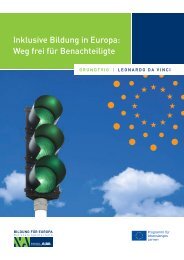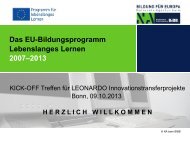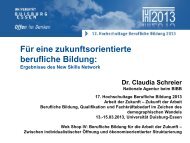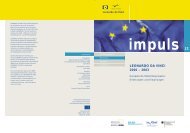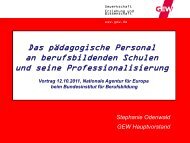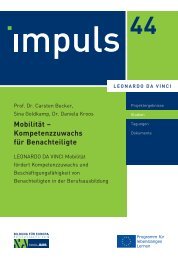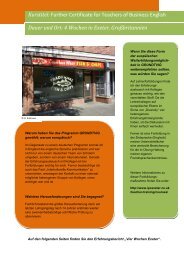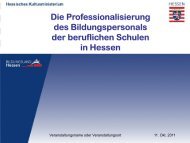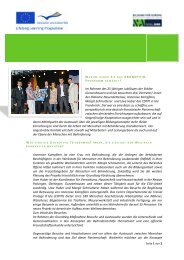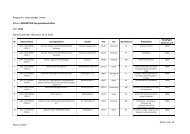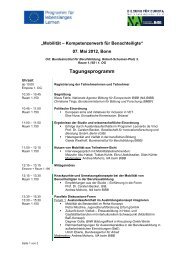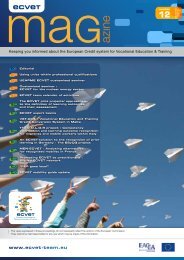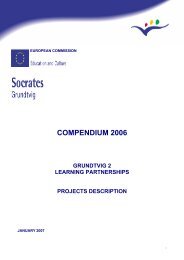als PDF-Datei zum Herunterladen - NA-BIBB
als PDF-Datei zum Herunterladen - NA-BIBB
als PDF-Datei zum Herunterladen - NA-BIBB
Erfolgreiche ePaper selbst erstellen
Machen Sie aus Ihren PDF Publikationen ein blätterbares Flipbook mit unserer einzigartigen Google optimierten e-Paper Software.
ecognition of european learning<br />
outcomes using the example of<br />
skilled occupations in the met<strong>als</strong><br />
sector<br />
The European Credit system for Vocational Education and Training (ECVET) is<br />
being increasingly tested in practice. This system is intended to facilitate students´<br />
periods spent abroad as part of their training, and above all enable recognition of<br />
learning outcomes attained abroad. Through its instruments, the LEO<strong>NA</strong>RDO DA<br />
VINCI transfer of innovation project MOVET II (Modules for Vocational Education<br />
and Training for Competences in Europe II) offers the possibility of having technical<br />
competences – which have been acquired within the scope of professional training<br />
abroad – recognised by the home training institution. After having acquired from<br />
the forerunner-project MOVET initial insights and informative progress reports<br />
concerning exemplary implementation of mobility in the training sector of mechatronics<br />
technicians, the focus in MOVET II is on recognition and transparency of<br />
vocational competences in skilled occupations in the met<strong>als</strong> sector.<br />
initial situation<br />
The development of personal and social<br />
competences of future skilled employees<br />
from work-related periods abroad (mobility)<br />
is a significant factor when companies<br />
decide to send their students abroad. The<br />
gain in the technical expertise sector has<br />
been somewhat neglected up to now, but it<br />
harbours in addition enormous potential<br />
for further developing European mobility<br />
in the vocational training sector. It is necessary<br />
to present these vocational-fieldspecific<br />
technical competences trans-<br />
parently, in order to enable a subsequent<br />
recognition by the home training institu-<br />
tion. MOVET II takes this as its starting<br />
point and develops modules and recognition<br />
instruments for the transnational<br />
qualification of professions within the<br />
met<strong>als</strong> sector. For the participants concerned,<br />
there is moreover a particularly<br />
European value in linking the elements of<br />
ECVET to the structures of the European<br />
Qualifications Framework (EQF). It will<br />
therefore be specified at the beginning<br />
of MOVET II that all modules are to be<br />
aligned to EQF level 4. Setting the niveau<br />
at level 4 corresponds to the categorisation<br />
of the three to four year met<strong>als</strong> training pro-<br />
grammes of the participating countries.<br />
MoVeT ii – Procedural method<br />
Two approved approaches are selected for<br />
module development. Firstly, analysis of<br />
the curricula is undertaken for mechatronics<br />
technicians from Germany and<br />
the participating partner-countries of<br />
Denmark, Finland and Slovakia, in order<br />
to find suitable content for transnational<br />
modules. Secondly, the project relates to<br />
the VQTS-model (Vocational Qualification<br />
Transfer System) and utilises the<br />
competence matrix for mechatronics<br />
technicians and the matrix for mechanics<br />
in industry analogous with the one<br />
developed in the MOVET II project. The<br />
VQTS-model utilises a systematic process<br />
for the description of work-related competences<br />
and benefits the vocational schools<br />
from the four participating countries as a<br />
common starting point for the development<br />
of modules. The English-language<br />
modules are specially conceived for trans-<br />
national exchange and uniformly structured<br />
according to learning outcomes. The<br />
target group for the three-week learning<br />
units in each case are students in their<br />
second and third year of training. The six<br />
qualification modules for automation<br />
technology, which have been tested within<br />
the scope of transnational mobility, are:<br />
Bus systems in Copenhagen,<br />
Bus systems in Pori,<br />
CAD/CAM (Computer-aided design<br />
and manufacturing) in Weiden,<br />
CNC (Computer numerical control)<br />
in Spišská Nová Ves,<br />
E-Pneu (Electro-pneumatic control)<br />
in Munich,<br />
Hydraulics in Copenhagen and<br />
PLC (Programmable logic control)<br />
in Munich,<br />
MOVET II stands out particularly by<br />
having tested these results in practice<br />
within the project’s duration. Students<br />
from all four participating countries take<br />
part in the modules and the concluding<br />
examinations. Specially designed guide-<br />
lines for the validation of learning outcomes,<br />
for formulating a Memorandum of<br />
Understanding as well as for the development<br />
of mobility help in implementation.<br />
The Memorandum of Understanding, recognised<br />
as a declaration of intent between<br />
the training institute partners, sets out<br />
agreements on competences which are to<br />
be achieved during the period of training<br />
abroad, on the training programme offered<br />
during this period, the names of contact<br />
persons, as well as responsibilities of the<br />
participants. The framework conditions<br />
for mobility according to ECVET criteria<br />
are thus transparent for all participating<br />
partners.<br />
recognition through transparency<br />
A recognition by the home training institutions<br />
of technical competences attained<br />
abroad can only take place if the<br />
continued on page 6



